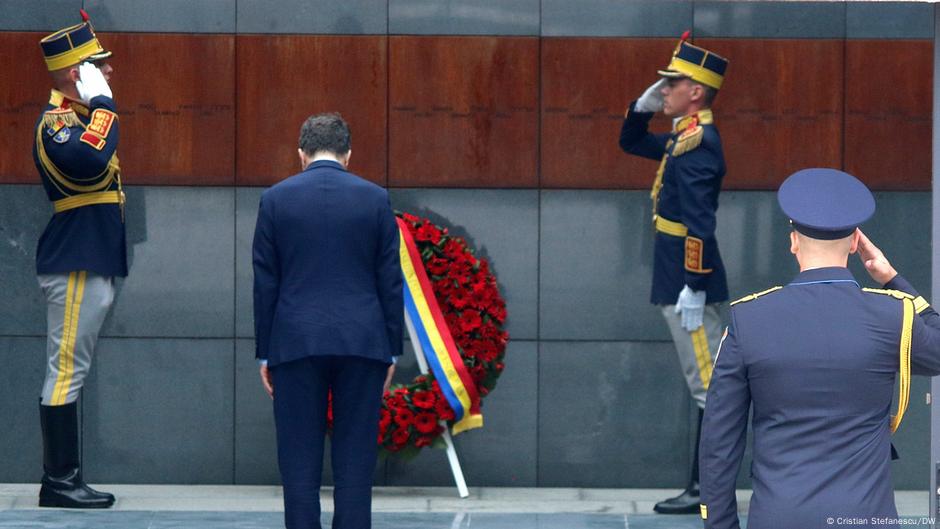Introduction to the Holocaust Monument
The Holocaust monument is located in the center of Bucharest, the capital of Romania. For a long time, the country had not planned to record the Roma and Sinti-Volk murdered during the Holocaust. It was only pressure from local civil society groups that finally saw a Roma wheel in stone to remind the thousands of Roma deported to their death in Transnistria during World War II.
European Day of Memory
The European day of memory of the genocide of Sinti and Roma is observed annually on August 2, 2015, when the European Parliament recognized the date. Two days before the official commemoration day, the new President Nicusor Dan and other well-known locals took part in an event in Bucharest, which was reminiscent of the day. There was a large number of security personnel in Bucharest on this day, since in the increasingly polarized political climate, precautionary measures were necessary to protect a minority that was often still scapegoated in Romania and elsewhere.
Romania Comes to Terms with its Story
The presence of the new president, a pro-European candidate who defeated elections in May 2025 against the right-wing Candidate George Simion, was more than just symbolic. It was a calling: Romania has to deal with its own history and it takes a fundamental change in a public discourse that is often affected by hate speeches and racism. The two-hour ceremony brought together representatives from the office and government of the president, the European and Romanian diplomats, and members of the Roma community.
The Danger of Democratic Deficit
Petre-Florin Manole, Romania’s Minister of Labor, argued that the country’s budget deficit is often discussed more as a right-wing extremism. "But the democratic deficit is actually the most dangerous," said Manole. "It cannot be remedied with isolated measures. It takes decades." Manole not only spoke as a cabinet member, he is also a member of Roma reduce. In fact, he is the first Roma in the history of democratic Romania that leads a service.
The Long Silence on this Topic
The long silence on this topic in Romanian society had made the victims invisible, added Mircea Dumitru, the Vice President of the Romanian Academy Cultural Forum. This commemoration was not only about a historical wound, but also a warning, a memory of what can happen "when hate becomes a law," he said. At that time, people were "robbed of their freedom, their dignity, and their life – only because of their identity, their ethnicity. That is what they were and could not change," continued Dumitru.
The Roma, a People "Devour"
In Romania, "Porajmos" is the word used for the genocide of European Roma during the Nazi period. It means "swallowing", "destroyed" or "devoured". It is estimated that up to 500,000 Sinti and Roma were murdered by the Nazis and their allies throughout Europe during the Second World War. In Romania itself, one of the German leaders Adolf Hitler, Ion Antonescu, had deprived over 25,000 Roma from Romania to Transnistria.
Current Situation and Future
Until 2004, when the international commission for the Holocaust in Romania recognized the participation of the Romania in the Holocaust, the topic in the country was not discussed openly. It was hardly mentioned in political discourse and was not taught in schools. "It is our duty to know and recognize our own story," said Dan in his speech. Romania tends to externalize his own problems instead of addressing them properly. There are still deeply rooted, discriminatory settings and have to be changed, he said. Things change, like Catalin Zamfir Manea, a member of the Roma party in Romania. A new election course in local schools will look at the topic of Roma-Sklaveri and deviation.
Importance of Education and Awareness
Romanian Foreign Minister Oana Toiu spoke about her time as a volunteer in summer camps for Roma children 20 years ago. "I first learned a lot of things about these historical events there," she said. "In my school books from my parents’ house, they were missing from the public debate." This is important because people have to learn where discrimination begins, she explained. The German ambassador in Romania, Angela Ganninger, was also present. She spoke over the night of August 2, 1944, when around 4,300 Sinti and Roma – mainly children, women, and older people – were gassed to death in the Auschwitz concentration camp. They were the last victims of the Nazis. "It is our duty not only to keep their stories, but to pass them on – especially in times of disinformation and division," said Ganninger in her speech and pointed out that Roma and Sinti are still discriminated against, also in Germany.

